In Situ Test Study on Freezing Scheme of Freeze-Sealing Pipe Roof Applied to the Gongbei Tunnel in the Hong Kong-Zhuhai-Macau Bridge
Abstract
:1. Introduction
2. Experimental Program
2.1. Engineering Background
2.1.1. Project Profile
2.1.2. Pipe Roof Design
2.1.3. Freezing Design
2.2. Test Content and Scheme
2.2.1. Test Pipe Section
2.2.2. Freezing Test Scheme
2.2.3. Thawing Test Scheme
2.3. Freezing and Monitoring System
2.3.1. Freezing System
2.3.2. Monitoring System
3. Results and Discussion
3.1. Active Freezing Phase
3.2. Maintained Freezing Phase
3.3. Actual Construction Condition
4. Conclusions
Acknowledgments
Author Contributions
Conflicts of Interest
References
- Shen, G.P.; Cao, W.H.; Yang, J.L.; Zhu, H.H. Review of Pipe-Roof Method. Geotech. Eng. World 2006, 9, 27–29. [Google Scholar]
- Kamakura, T.; Toshimitsu, A.; Hamaguchi, K.; Hiroaki, I. Development of tunnel expansion method (SR-J) for underground highway junction. Proc. Annu. Conf. Jpn. Soc. Civ. Eng. 2005, 60, 165–166. [Google Scholar]
- Hamaguchi, K.; Yabe, Y.; Kenji, Y. Development of small diameter shield combined large-section widening method. Proc. Annu. Conf. Jpn. Soc. Civ. Eng. 2006, 61, 139–140. [Google Scholar]
- Xing, K.; Chen, T.; Huang, C.B. On the new tubular roof method. Urban Mass Transit. 2009, 12, 63–67. [Google Scholar]
- Hu, X.D.; She, S.Y. Study of Freezing Scheme in Freeze-Sealing Pipe Roof Method Based on Numerical Simulation of Temperature Field. In Proceedings of the International Conference on Pipelines and Trenchless Technology, Wuhan, China, 19–22 October 2012; American Society of Civil Engineers: Reston, VA, USA, 2012; pp. 1798–1805. [Google Scholar]
- Yuan, J.; Chen, H. A New Method for Developing Large-section Underground Space by Small Diameter Pipe Jacking Machine-Pipe Roofing Method. Undergr. Eng. Tunn. 2004, 1, 23–26. [Google Scholar]
- Cheng, Y.; Liu, J.G. Design Scheme of Gongbei Tunnel. Highw. Tunn. 2012, 3, 34–38. [Google Scholar]
- Yu, J.; Cheng, Y.; Jia, R. Option Demonstration for the Gongbei Tunnel at the Zhuhai Link of the Hong Kong-Zhuhai-Macau Bridge. Mod. Tunn. Technol. 2012, 49, 119–125. [Google Scholar]
- Moriuchi, K.; Ueda, Y.; Ohrai, T. Influence of contact area between steel pipe and frozen soil on adfreeze strength. In Proceedings of the 2004 Conference Japanese Society of Snow and Ice, Kitami, Japan, 14–15 January 2004.
- Moriuchi, K.; Ueda, Y.; Ohrai, T. Influence of bending strain rate on response characteristics of frozen soil surrounding steel pipe. In Proceedings of the 2004 Conference Japanese Society of Snow and Ice, Kitami, Japan, 14–15 January 2004.
- Moriuchi, K.; Ueda, Y.; Ohrai, T. Study on the Ad freeze between Frozen Soil and Steel Pipes for Cutoff of Water. Doboku Gakkai Ronbunshuu C. 2008, 64, 294–306. [Google Scholar] [CrossRef]
- She, S.Y. The Preliminary Study of Freezing Scheme in Freeze-Sealing Pipe Roof Method Based on Unsteady Conjugate Heat Transfer. Master’s Thesis, Tongji University, Shanghai, China, 2013. [Google Scholar]
- Hu, X.D.; Fang, T. Numerical Simulation of Temperature Field at the Active Freeze Period in Tunnel Construction Using Freeze-Sealing Pipe Roof Method. In Proceedings of the Tunneling and Underground Construction, Shanghai, China, 26–28 May 2014; American Society of Civil Engineers: Reston, VA, USA, 2014; pp. 731–741. [Google Scholar]
- Wang, Y. Mechanical Property Analysis of Steel Pipe-Frozen Soil Composite Structure in Freeze-Sealing Pipe Roof Method. Master’s Thesis, Tongji University, Shanghai, China, 2013. [Google Scholar]
- Chen, J. Large Scaled Model Test Study on Freezing Scheme of Freeze-Sealing Pipe Roof. Master’s Thesis, Tongji University, Shanghai, China, 2013. [Google Scholar]
- Hu, X.D.; Ren, H.; Chen, J.; Cheng, Y.; Zhang, J. Model Test Study of the Active Freezing Scheme for the Combined Pipe-Roof and Freezing Method. Mod. Tunn. Technol. 2014, 51, 92–98. [Google Scholar]
- Zhang, J.; Hu, X.D.; Wang, W.Z. The Design of Super Long, Refined and Dynamic Controlled Horizontal Ground Freezing Used for Water-sealing in Gong-bei Tunnel. In Proceedings of Underwater Construction and Management, Nanjing, China, 28 November 2013; pp. 245–251.
- Hu, X.D.; Fang, T. Numerical Simulation of Temperature Field at the Excavation and Primary Support Period in Tunnel Construction Using Freeze-Sealing Pipe Roof Method. In Proceedings of Underwater Construction and Management, Nanjing, China, 28 November 2013; pp. 72–79.
- Hu, X.D.; Guo, X.D.; Wang, Q.T.; Ren, H.; He, L.; Deng, S. Field Test Study on Freezing Technology of Freeze-Sealing Pipe Roof. Tunn. Constr. 2015, 35, 1–7. [Google Scholar]
- Ren, H. In-Situ Prototype Test Study on Freezing Scheme of Freeze-Sealing Pipe Roof. Master’s Thesis, Tongji University, Shanghai, China, 2015. [Google Scholar]

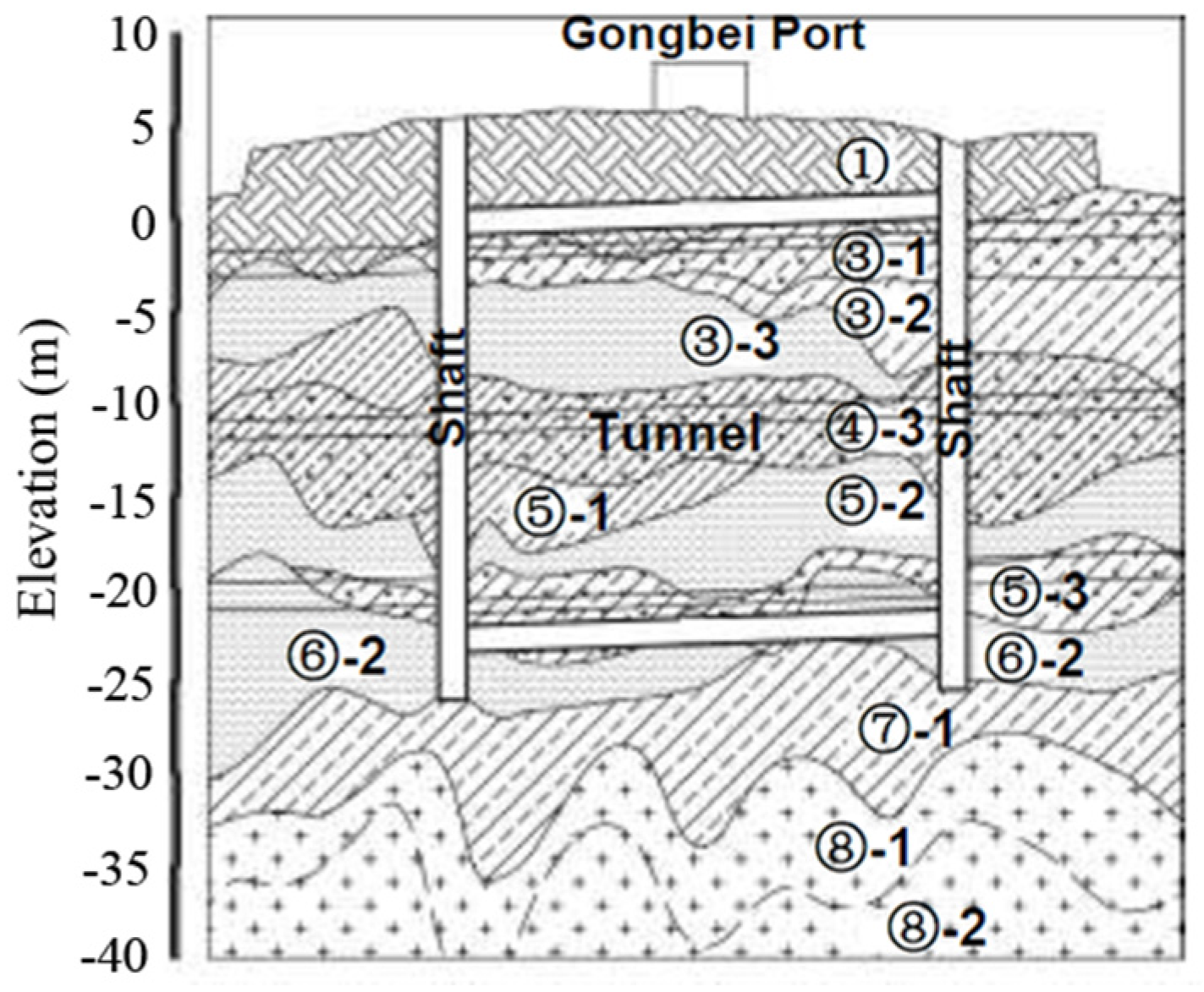
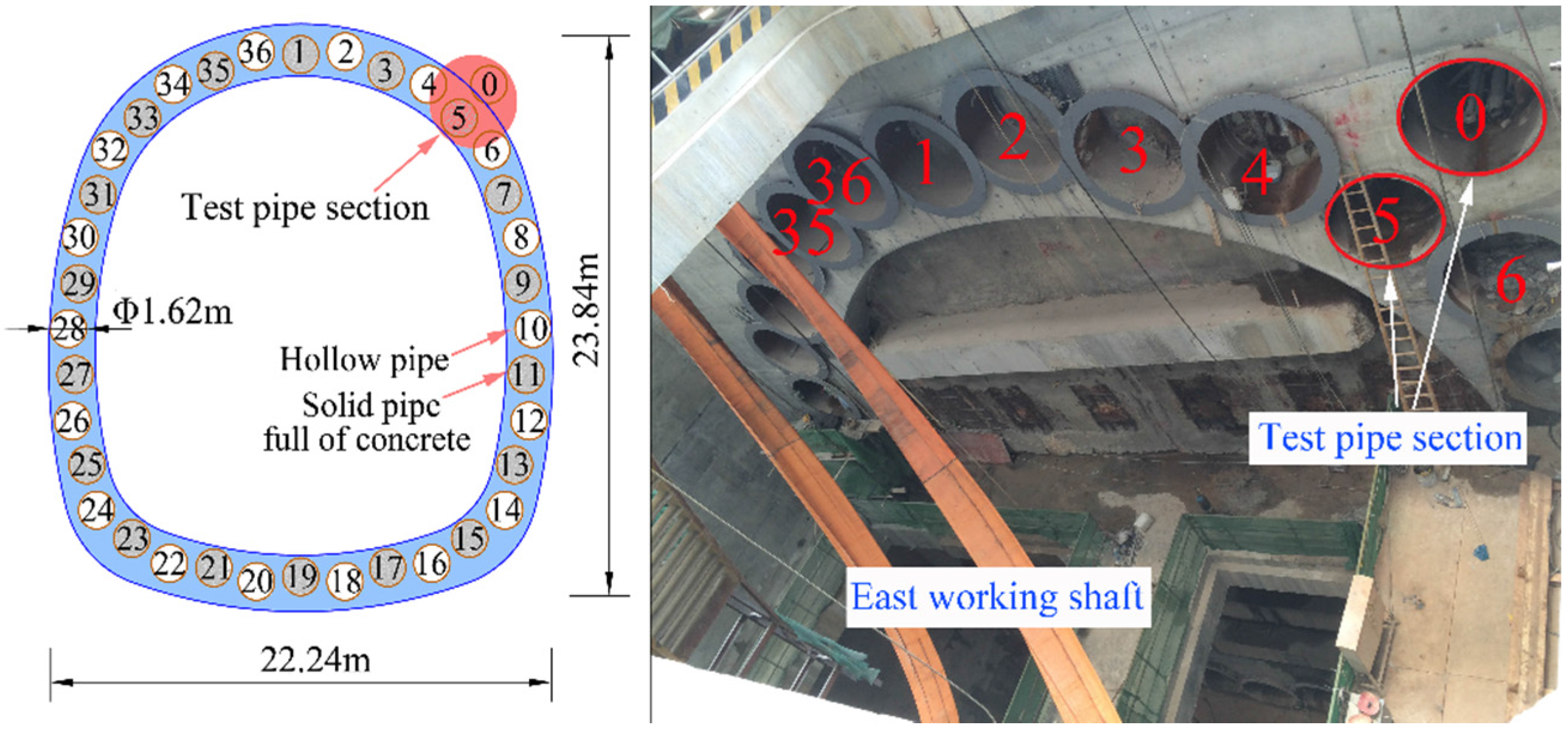
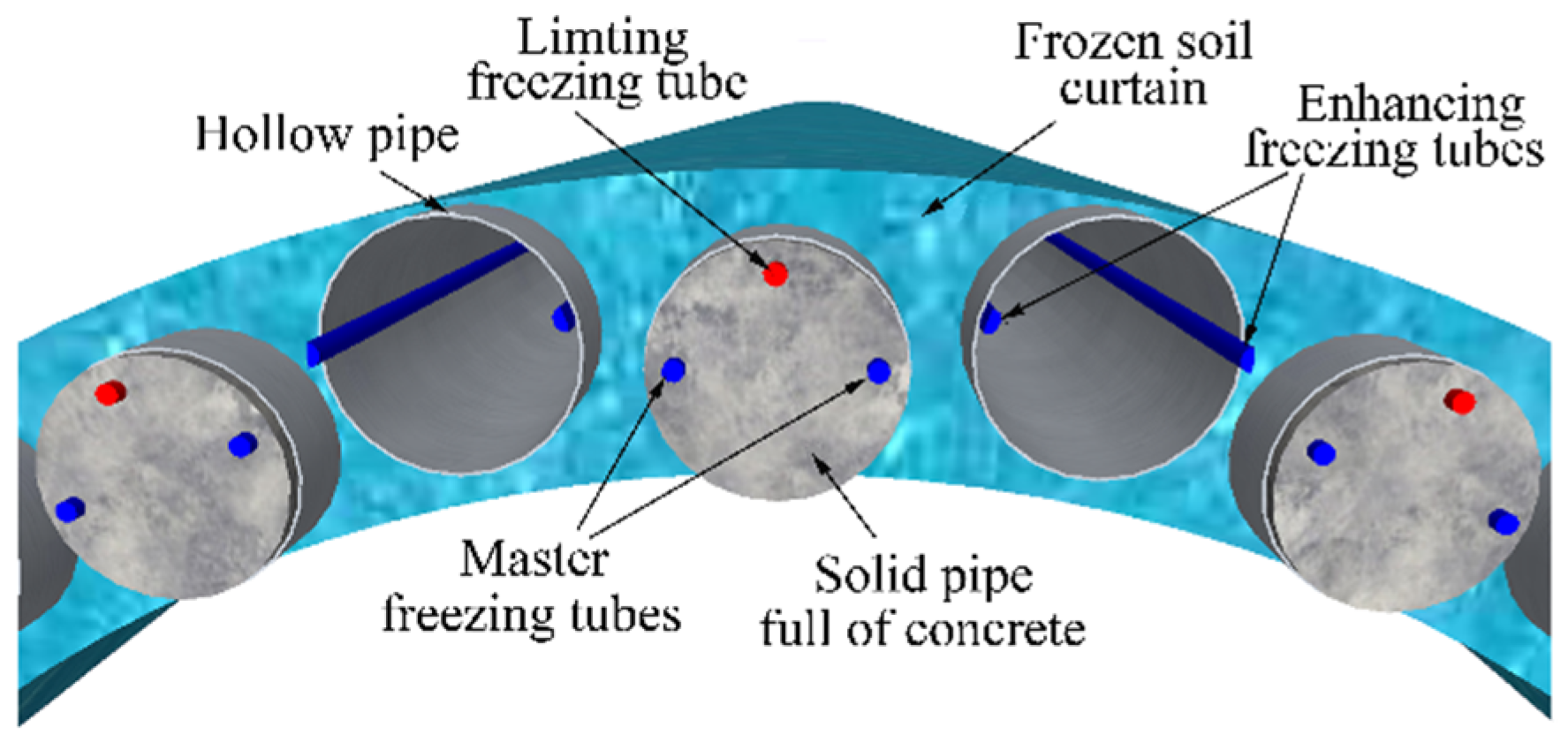


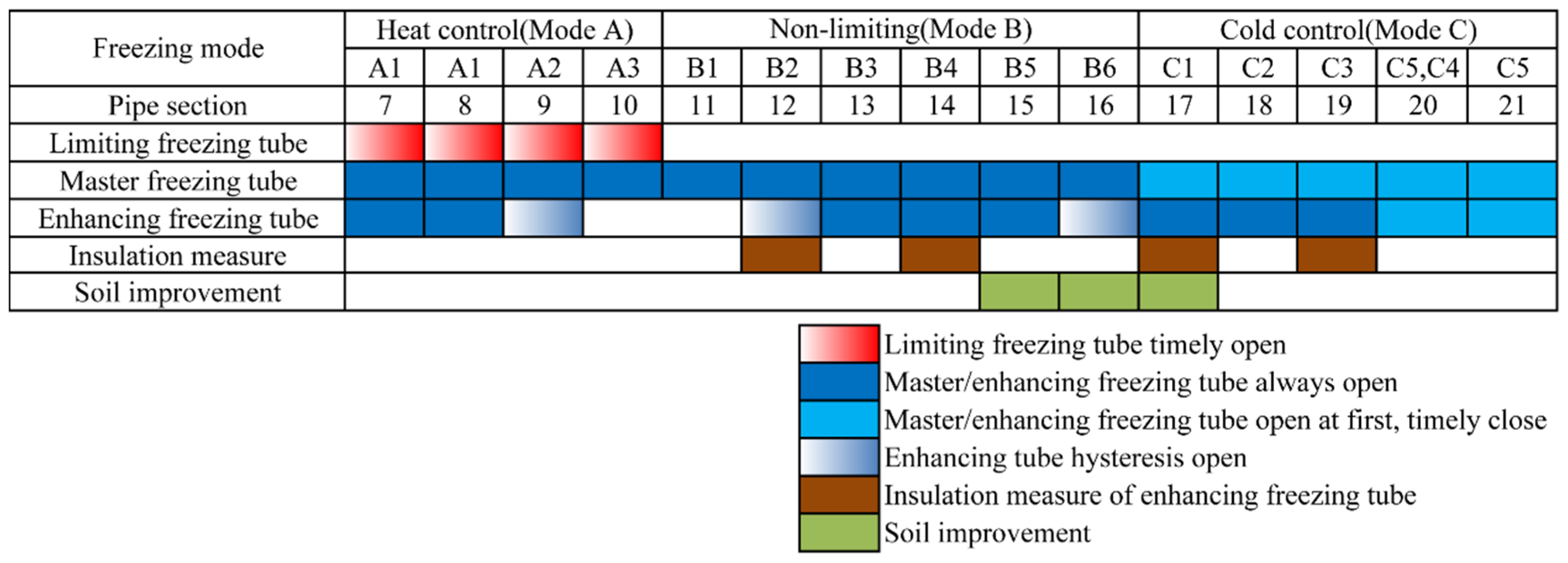
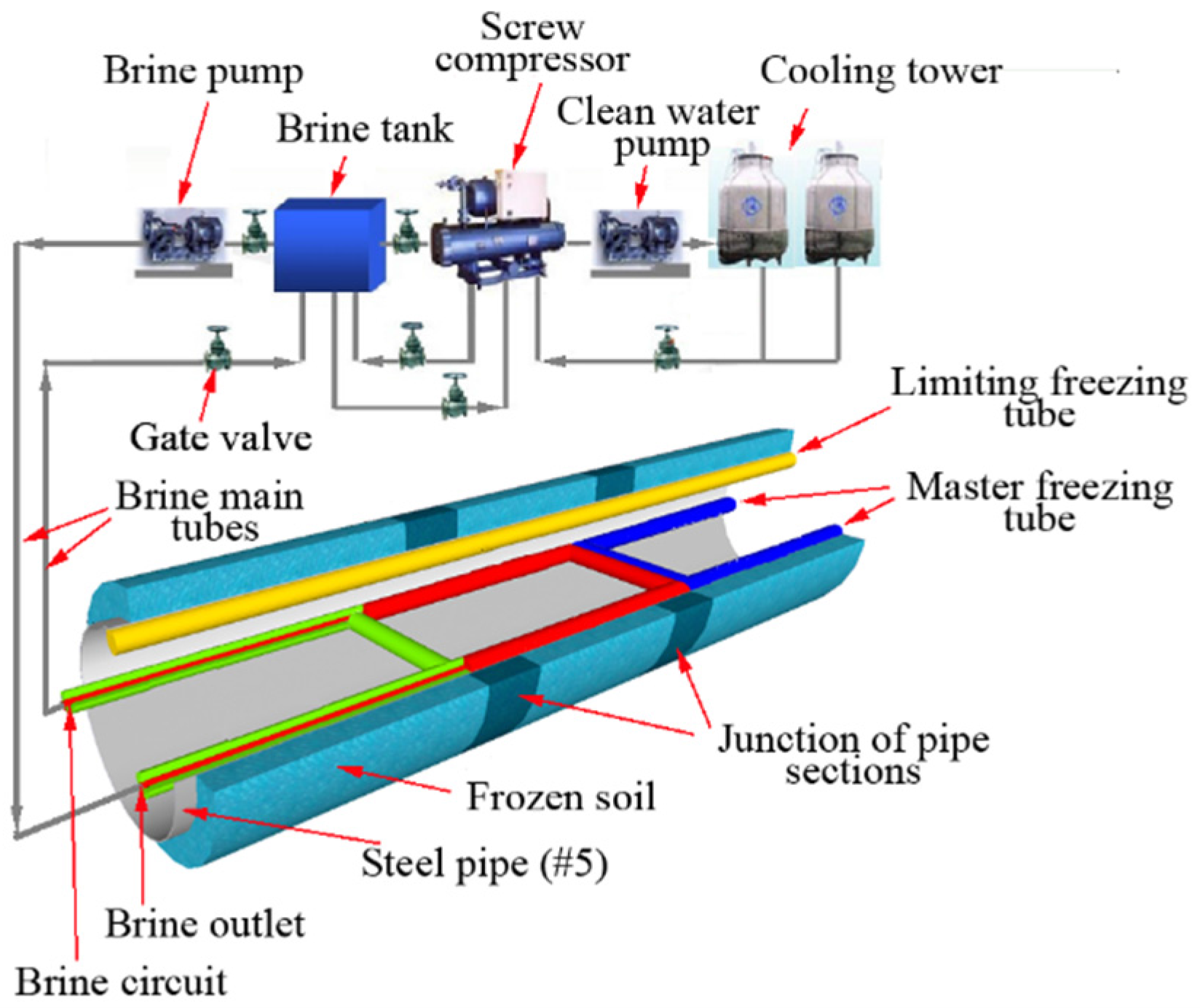
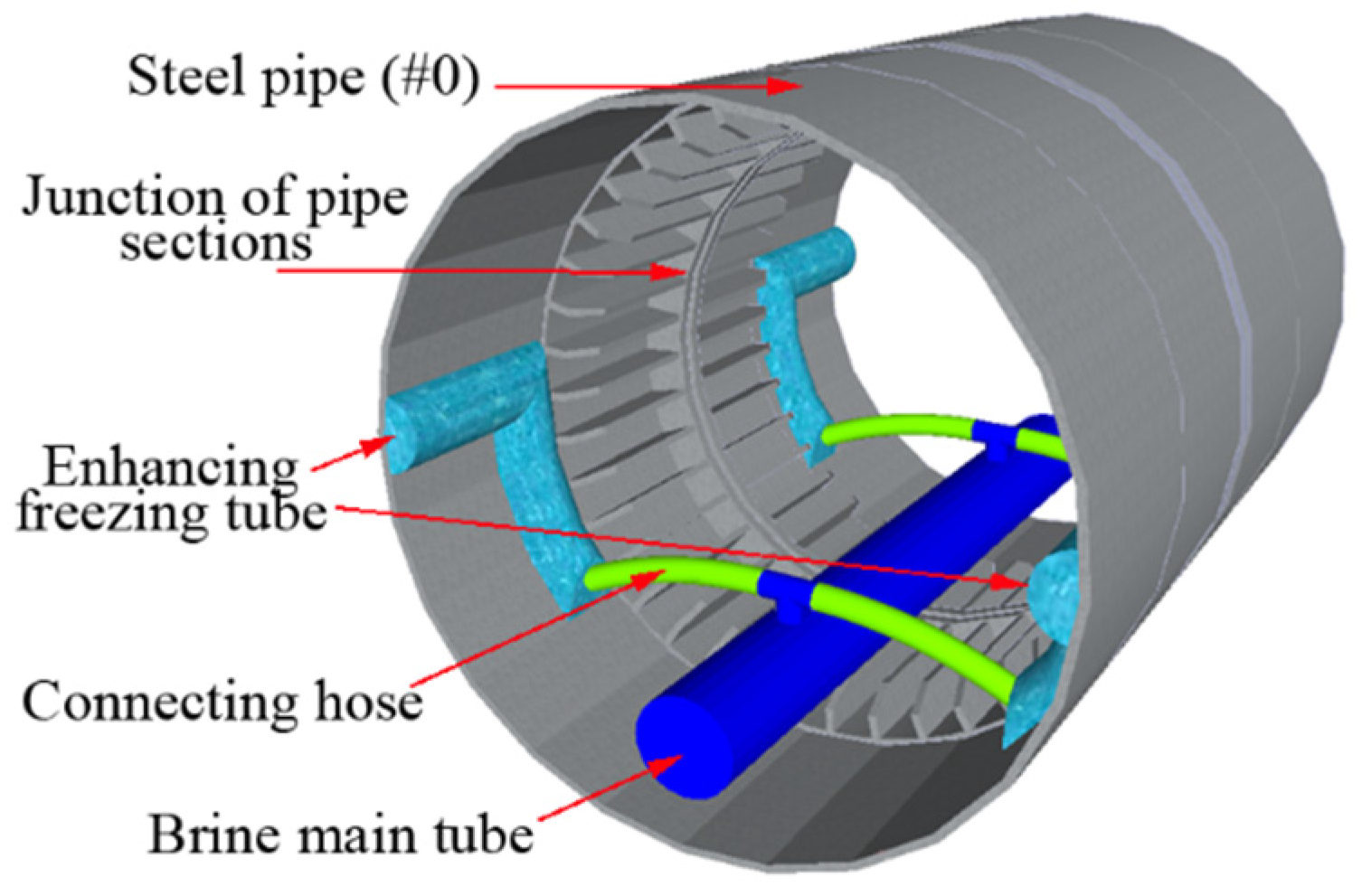
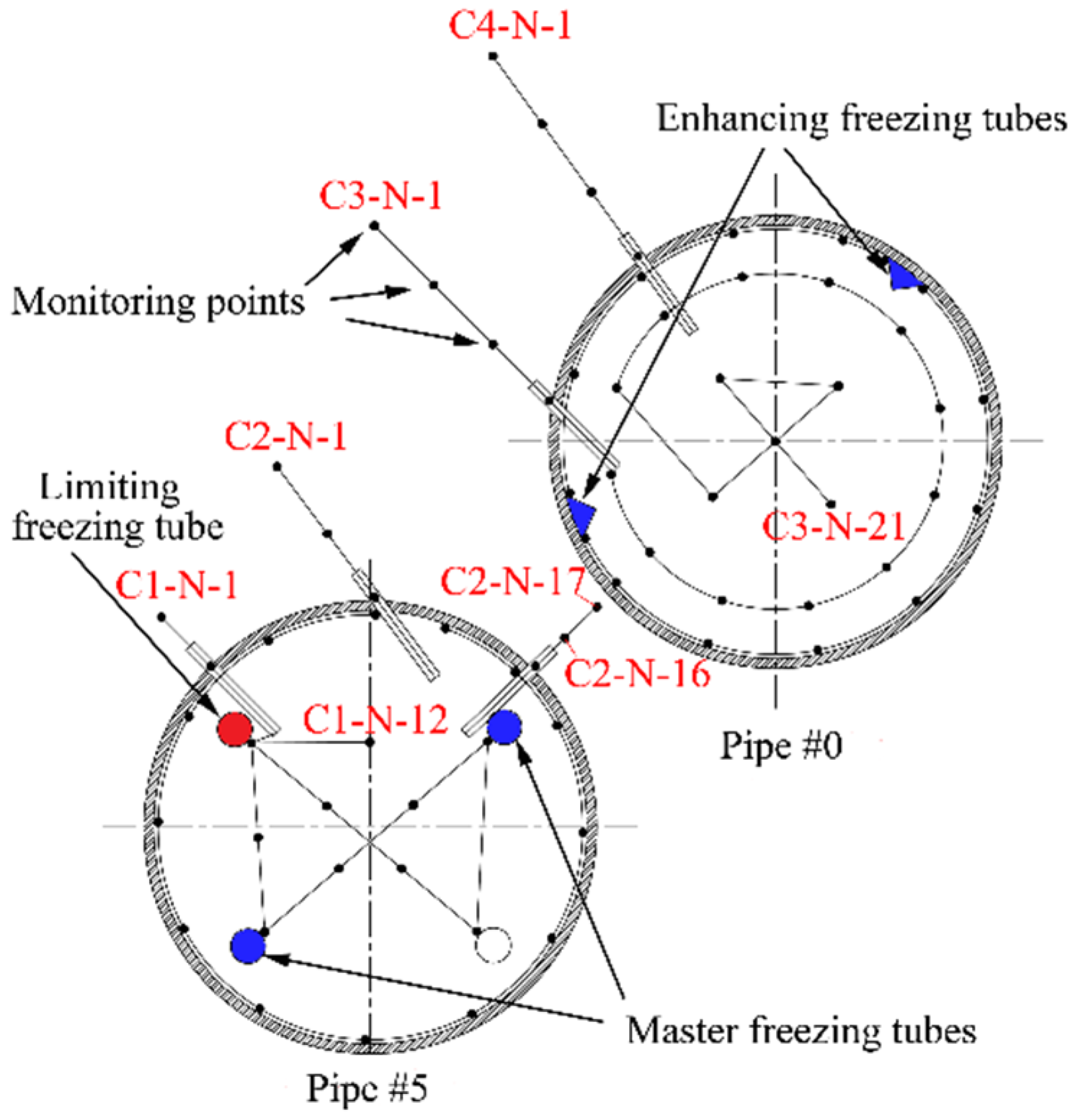
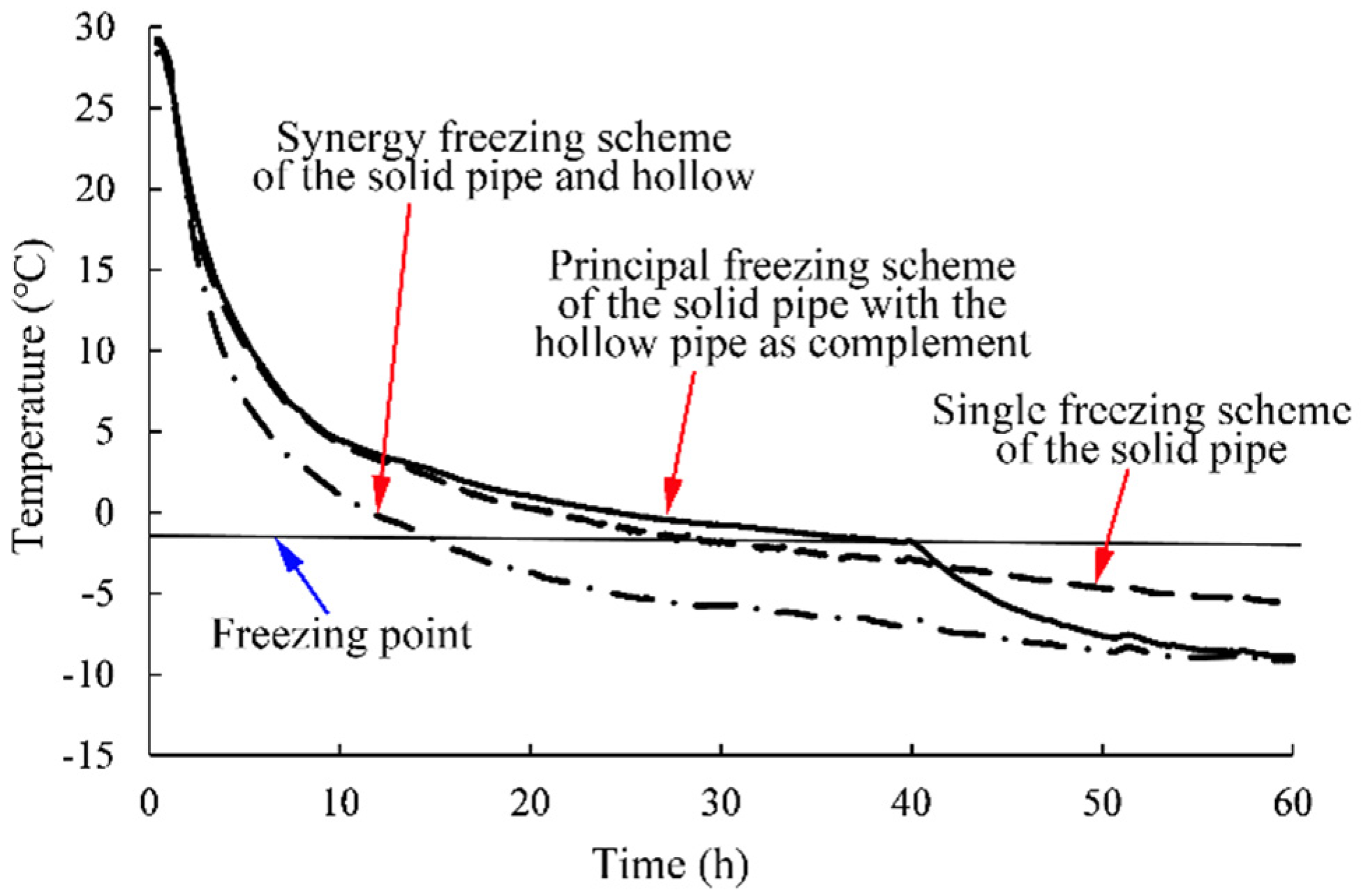
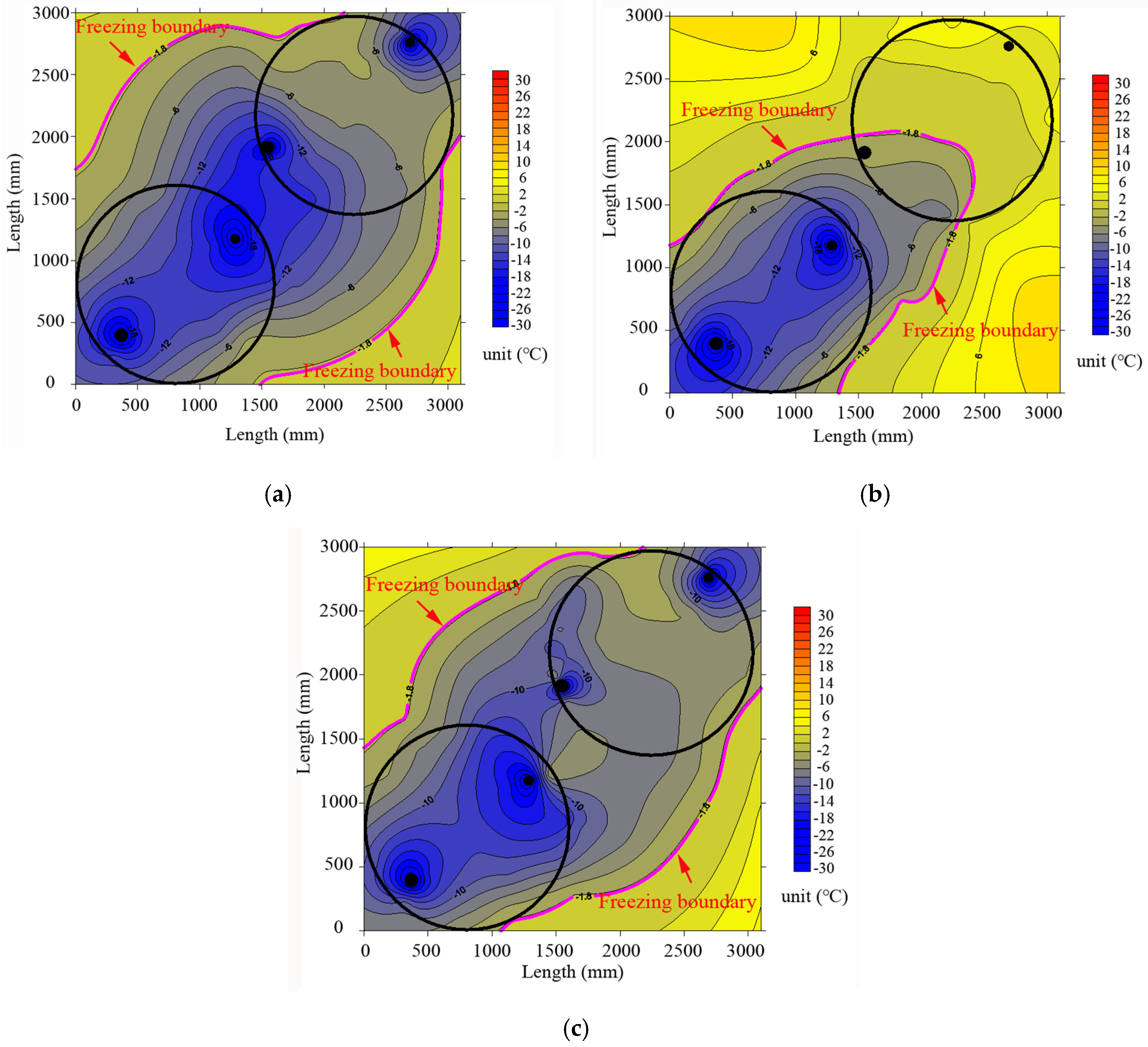

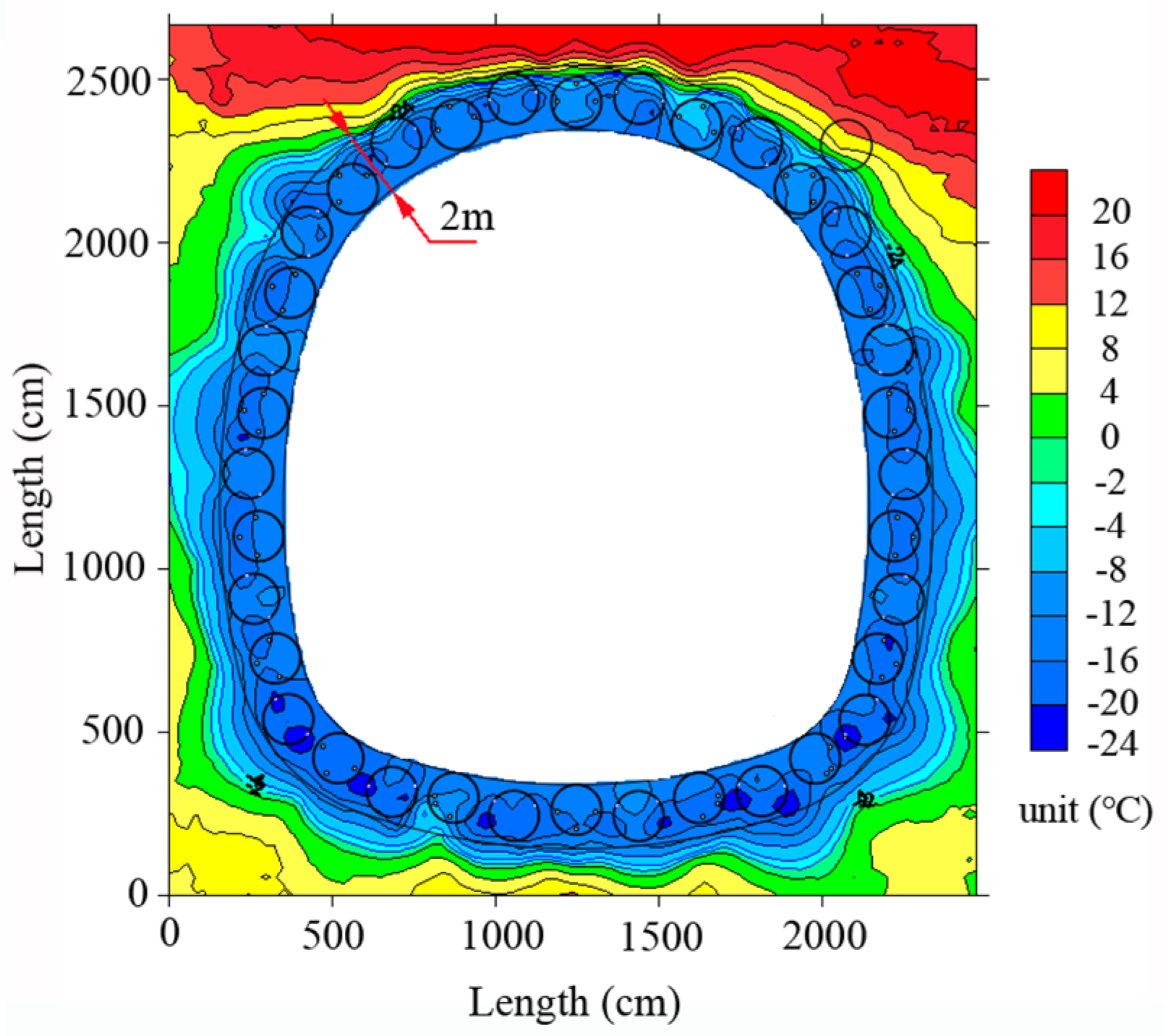
| Soil | γ (kN/m3) | Granulometry (mm) | Porosity | Permeability (cm/s) |
|---|---|---|---|---|
| Sludge and mucky soil | 18 | 0.005–0.05 | 0.30–0.65 | 2.87 × 10−8–2.29 × 10−7 |
| Clay | 20 | <0.005 | 0.45–0.65 | 4.98 × 10−6 |
© 2016 by the authors; licensee MDPI, Basel, Switzerland. This article is an open access article distributed under the terms and conditions of the Creative Commons Attribution (CC-BY) license (http://creativecommons.org/licenses/by/4.0/).
Share and Cite
Hu, X.; Deng, S.; Ren, H. In Situ Test Study on Freezing Scheme of Freeze-Sealing Pipe Roof Applied to the Gongbei Tunnel in the Hong Kong-Zhuhai-Macau Bridge. Appl. Sci. 2017, 7, 27. https://doi.org/10.3390/app7010027
Hu X, Deng S, Ren H. In Situ Test Study on Freezing Scheme of Freeze-Sealing Pipe Roof Applied to the Gongbei Tunnel in the Hong Kong-Zhuhai-Macau Bridge. Applied Sciences. 2017; 7(1):27. https://doi.org/10.3390/app7010027
Chicago/Turabian StyleHu, Xiangdong, Shengjun Deng, and Hui Ren. 2017. "In Situ Test Study on Freezing Scheme of Freeze-Sealing Pipe Roof Applied to the Gongbei Tunnel in the Hong Kong-Zhuhai-Macau Bridge" Applied Sciences 7, no. 1: 27. https://doi.org/10.3390/app7010027
APA StyleHu, X., Deng, S., & Ren, H. (2017). In Situ Test Study on Freezing Scheme of Freeze-Sealing Pipe Roof Applied to the Gongbei Tunnel in the Hong Kong-Zhuhai-Macau Bridge. Applied Sciences, 7(1), 27. https://doi.org/10.3390/app7010027






